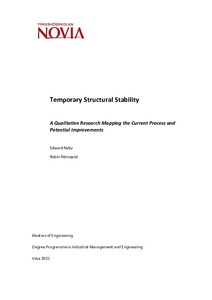Temporary Structural Stability : A Qualitative Research Mapping the Current Process and Potential Improvements
Rönnqvist, Robin; Nyby, Edward (2021)
Rönnqvist, Robin
Nyby, Edward
2021
All rights reserved. This publication is copyrighted. You may download, display and print it for Your own personal use. Commercial use is prohibited.
Julkaisun pysyvä osoite on
https://urn.fi/URN:NBN:fi:amk-2021052812211
https://urn.fi/URN:NBN:fi:amk-2021052812211
Tiivistelmä
The single story projects at the target company have become larger and higher. Time schedules have become shorter to maintain the efficiency and the steel frame is optimized to increase the profit. This has created an increased demand of temporary bracing to ensure the structural stability and safety during installation phase.
The purpose was to map the internal process and explore how the target company during different stages of the project can make decisions that work in favor of the stability. The aim was to investigate how the process can be improved and made more standardized in order to minimizes the need for temporary bracing.
The theoretical framework consists of gathered literature regarding business process improvement, project management and risk and safety management. The research method used was action research and data collection were done by semi structured group interviews. The data was recorded, transcribed and analyzed.
The outcome of the analyzed data was coded into three themes in order to answer the research questions. The conclusion was that a better description of the process was needed in order to be able to standardize and improve it. The main contribution was a specific model for a well working process for the target company. An important step in creating the model was to clarify the division of responsibility in projects. A budget for the follow-up of the costs was also suggested to give the possibility to measure and monitor the development of the process. Envånings projekten hos målföretaget har blivit allt större och högre. Tidplanerna har blivit kortare för att bibehålla effektiviteten och stålramen är optimerad för att öka vinsten. Detta har skapat en ökad efterfrågan på tillfällig stagning för att säkerställa strukturell stabilitet och säkerhet under installationsfasen.
Syftet var att kartlägga den interna processen och undersöka hur målföretaget under olika stadier av projektet kan fatta beslut som fungerar till förmån för stabiliteten. Syftet var att undersöka hur processen kan förbättras och göras mer standardiserad för att minimera behovet av tillfällig stagning.
Den teoretiska ramen består av samlad litteratur om förbättring av affärsprocesser, projektledning samt risk- och säkerhetshantering. Den forskningsmetod som användes var aktionsforskning och datainsamlingen gjordes med semistrukturerade gruppintervjuer. Intervjuerna spelades in, transkriberades och analyserades.
Resultatet av den analyserade informationen kodades till tre teman för att svara på forskningsfrågorna. Slutsatsen var att en bättre beskrivning av processen behövdes för att den skulle kunna standardiseras och förbättras. Huvudsakliga bidraget var en specifik modell för en väl fungerande process för målföretaget. Ett viktigt steg i att skapa modellen var att förtydliga ansvarsfördelningen i projekten. En budget för uppföljning av kostnader skulle ge möjlighet att mäta och övervaka förändringar.
The purpose was to map the internal process and explore how the target company during different stages of the project can make decisions that work in favor of the stability. The aim was to investigate how the process can be improved and made more standardized in order to minimizes the need for temporary bracing.
The theoretical framework consists of gathered literature regarding business process improvement, project management and risk and safety management. The research method used was action research and data collection were done by semi structured group interviews. The data was recorded, transcribed and analyzed.
The outcome of the analyzed data was coded into three themes in order to answer the research questions. The conclusion was that a better description of the process was needed in order to be able to standardize and improve it. The main contribution was a specific model for a well working process for the target company. An important step in creating the model was to clarify the division of responsibility in projects. A budget for the follow-up of the costs was also suggested to give the possibility to measure and monitor the development of the process.
Syftet var att kartlägga den interna processen och undersöka hur målföretaget under olika stadier av projektet kan fatta beslut som fungerar till förmån för stabiliteten. Syftet var att undersöka hur processen kan förbättras och göras mer standardiserad för att minimera behovet av tillfällig stagning.
Den teoretiska ramen består av samlad litteratur om förbättring av affärsprocesser, projektledning samt risk- och säkerhetshantering. Den forskningsmetod som användes var aktionsforskning och datainsamlingen gjordes med semistrukturerade gruppintervjuer. Intervjuerna spelades in, transkriberades och analyserades.
Resultatet av den analyserade informationen kodades till tre teman för att svara på forskningsfrågorna. Slutsatsen var att en bättre beskrivning av processen behövdes för att den skulle kunna standardiseras och förbättras. Huvudsakliga bidraget var en specifik modell för en väl fungerande process för målföretaget. Ett viktigt steg i att skapa modellen var att förtydliga ansvarsfördelningen i projekten. En budget för uppföljning av kostnader skulle ge möjlighet att mäta och övervaka förändringar.
